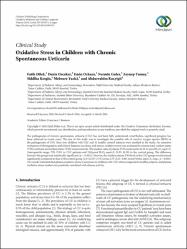Oxidative stress in children with chronic spontaneous urticaria

Göster/
Erişim
info:eu-repo/semantics/openAccessTarih
2016Yazar
Dilek, FatihÖzçeker, Deniz
Özkaya, Emin
Güler, Nermin
Tamay, Zeynep
Kesgin, Sıddıka
Koçyiğit, Abdurrahim
Üst veri
Tüm öğe kaydını gösterKünye
Dilek F, Ozceker D, Ozkaya E, Guler N, Tamay Z, Kesgin S, Yazici M, Kocyigit A. Oxidative stress in children with chronic spontaneous urticaria. Oxid Med Cell Longev. 2016; doi: 10.1155/2016/3831071.Özet
The pathogenesis of chronic spontaneous urticaria (CSU) has not been fully understood; nevertheless, significant progress has been achieved in recent years. The aim of this study was to investigate the possible role of reactive oxygen species (ROS) in the pathogenesis of CSU. Sixty-two children with CSU and 41 healthy control subjects were enrolled in the study. An extensive evaluation of demographic and clinical features was done, and serum oxidative stress was evaluated by plasma total oxidant status (TOS) and total antioxidant status (TAS) measurements. The median value of plasma TOS was found to be 10.49 μmol H2O2 equiv./L (interquartile range, 7.29–17.65) in CSU patients and 7.68 μmol H2O2 equiv./L (5.95–10.39) in the control group. The difference between the groups was statistically significant (p=0.003). Likewise, the median plasma TAS level in the CSU group was decreased significantly compared to that of the control group (2.64 [2.30–2.74] versus 2.76 [2.65–2.86] mmol Trolox equiv./L, resp., p = 0,001). Our results indicated that plasma oxidative stress is increased in children with CSU when compared to healthy subjects, and plasma oxidative stress markers are positively correlated with disease activity.

















